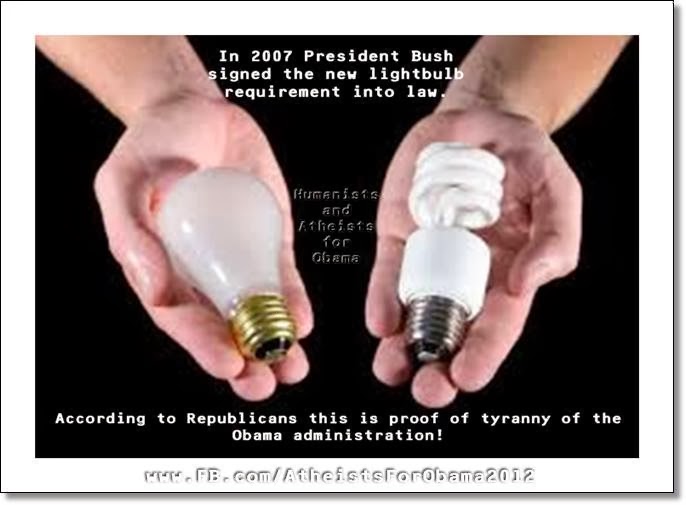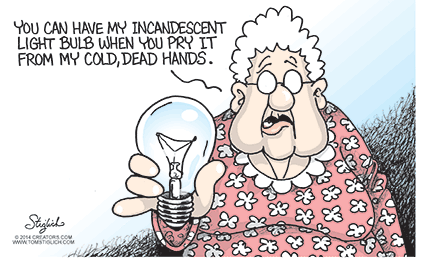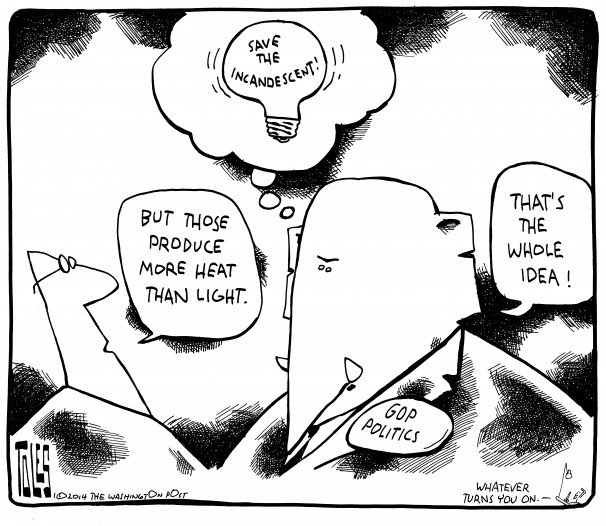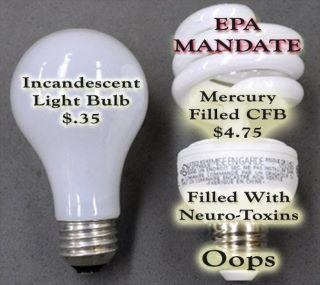You are using an out of date browser. It may not display this or other websites correctly.
You should upgrade or use an alternative browser.
You should upgrade or use an alternative browser.
Changing Light Bulbs
- Thread starter BigUnionGuy
- Start date
wkmac
Well-Known Member
Congrats More, I think you've finally posted a cartoon than many here will see as a complete reflection of your actual self and represents you well.

wkmac
Well-Known Member
There's always some joker in the bunch who wants to spoil a perfectly good narrative. You should be ashamed!
ImWaitingForTheDay
Annoy a conservative....Think for yourself
How so?There's always some joker in the bunch who wants to spoil a perfectly good narrative. You should be ashamed!
wkmac
Well-Known Member
Should note that not just incandescent bulbs are effected as some fluorescent are as well. The T12 tube bulb is phasing out and will be replaced by the T8 and my guess that in 2020' when the requirement goes up again, even the fluorescent lamps now will phase out as they will not meet the the new energy requirements. UPS is converting from the T12 now to T8's (some of you may have noticed your building getting a lighting upgrade recently) and we just learned a couple of days ago that our normal supplier for T12 ballasts no longer supply them. To say I was giggling at the thought of supervisors doing the Keystone Cop routine is understatement. Que the piano!
I've gone full LED at home (we love it) but you have to do the math and the application to make sure it's right. Fluorescent lamps do not like to be cycled on and off, this will lead to early failure and they aren't very keen on the cold either. Incandescent bulbs will be available but in a new energy efficient design. If you have a light that is turned on for short durations and cycled a lot, go with the new incandescent or consider stepping up to the LED.
We've been experimenting with LEDs in our building for several years and I love them. We installed LED's in our unload doors nearly 5 years ago and we've not touched them at all since. The old metal halides, would get a new bulb twice a year, ballast rebuild every 3rd lamp change at about $20 a pop for bulb plus my labor. Coil and core just under $100. The light form LED is also not near as harsh either compared to the metal halide. We installed one at the fuel island and a couple of wall packs mounted outside on the building with the same results. Never touched them while the other lights have been relamped along with new coil and core kits, some more than once. From a maintenance POV, LED's are a no brainer IMO. About to get some in the parking lot too (tomorrow) and looking forward to seeing (no pun) what the results are with them.
Rant away Moreluck cause the future is passing you by anyway!
I've gone full LED at home (we love it) but you have to do the math and the application to make sure it's right. Fluorescent lamps do not like to be cycled on and off, this will lead to early failure and they aren't very keen on the cold either. Incandescent bulbs will be available but in a new energy efficient design. If you have a light that is turned on for short durations and cycled a lot, go with the new incandescent or consider stepping up to the LED.
We've been experimenting with LEDs in our building for several years and I love them. We installed LED's in our unload doors nearly 5 years ago and we've not touched them at all since. The old metal halides, would get a new bulb twice a year, ballast rebuild every 3rd lamp change at about $20 a pop for bulb plus my labor. Coil and core just under $100. The light form LED is also not near as harsh either compared to the metal halide. We installed one at the fuel island and a couple of wall packs mounted outside on the building with the same results. Never touched them while the other lights have been relamped along with new coil and core kits, some more than once. From a maintenance POV, LED's are a no brainer IMO. About to get some in the parking lot too (tomorrow) and looking forward to seeing (no pun) what the results are with them.
Rant away Moreluck cause the future is passing you by anyway!
Catatonic
Nine Lives
I've gone full LED at home (we love it) but you have to do the math and the application to make sure it's right.
Rant away Moreluck cause the future is passing you by anyway!
Did the LEDs cost justify or did you do it for other reasons?
You just wait until moreluck gets to her typewriter ... you got it coming to you Skippy!
moreluck
golden ticket member
Nah, she's got too much hair!!Congrats More, I think you've finally posted a cartoon than many here will see as a complete reflection of your actual self and represents you well.


moreluck
golden ticket member
"Rant away Moreluck cause the future is passing you by anyway! ..."
I'm still ranting about ATM cards and all the tellers that said they would be free.......I knew there would be charges eventually and I never used one.
I'm set for light bulbs for the rest on my life. I don't care what anyone uses when I'm gone.
I'm still ranting about ATM cards and all the tellers that said they would be free.......I knew there would be charges eventually and I never used one.
I'm set for light bulbs for the rest on my life. I don't care what anyone uses when I'm gone.
UpstateNYUPSer(Ret)
Well-Known Member
I'm still ranting about ATM cards and all the tellers that said they would be free.......I knew there would be charges eventually and I never used one.
Mine is still 100% free with no minimum balance required.
I'm set for light bulbs for the rest on my life. I don't care what anyone uses when I'm gone.
It's nice to see that you still set goals for yourself.
Mine is still 100% free with no minimum balance required.
I'm set for light bulbs for the rest on my life. I don't care what anyone uses when I'm gone.
It's nice to see that you still set goals for yourself.
UpstateNYUPSer(Ret)
Well-Known Member
It's free for you to use at any bank in the US ?????????????????? Probably not.....
My bank refunds any ATM fees I may have to pay but I always take out enough money before going on vacation.
Catatonic
Nine Lives
Mine too.My bank refunds any ATM fees I may have to pay but I always take out enough money before going on vacation.
I keep wondering how much longer they will keep doing that.
wkmac
Well-Known Member
Did the LEDs cost justify or did you do it for other reasons?
Yes, No, All of the above. This is why you have to do the research. There are multiple issues to consider beyond the price at the checkout line.
As my wife and I prepare going into retirement with the idea of being off grid, I also wanted to see what the durability is of the LED. Being off grid I want to wire the house light circuits for 12 VDC (avoiding an inverter and it's own power consumption) which I can then use handmade LED lights without the need of a transformer. Store bought lamps have built in transformers as the LEDs can't take direct 120V power so it has to be stepped down. This is another reason LED's can be pricey.
I've already taken 2 Banker Lamps and built my own LED light array and wired in a 12 V transformer so I can plug into a 120 VAC source. They work great.
So in my case there are multiple incentives at play. Besides, if you read the Energy Act of 2007' the standards by 2020' if they remain and at this time I can't see that they won't, LED's may be the only lamps on the market that meet those standards. Bitch all you want but I don't see this as going away and with everyone screaming about the gov't taking away their light bulbs, I've seen none of you delving into who was really behind all of this in the first place.
It's always been a Lightbulb Conspiracy and it still is.
You just wait until moreluck gets to her typewriter ... you got it coming to you Skippy!
I don't think so. She and Roadrunner are an item these days and I don't see her as a cheater.

Babagounj
Strength through joy
Larry Birnbaum, owner of the Light Bulb Store in South Hackensack, thinks he has a bright idea for them. He developed the Newcandescent bulb, an incandescent bulb that meets new federal standards for so-called "rough" use (like in a moving car or truck) but that he wants to sell for everyday use.
He hopes to start selling the new bulbs in January. They will go for about $1.65 each, compared with about 60 cents for current incandescents and about $2.25 to $3.50 for compact fluorescents that give the equivalent of 100 watts of light.
Birnbaum made a few changes to the typical "rough-use" incandescent to meet new federal standards, including using krypton gas to make it last 10 times longer. But he acknowledged that they're not as energy-efficient as LEDs and compact fluorescents.
He hopes to start selling the new bulbs in January. They will go for about $1.65 each, compared with about 60 cents for current incandescents and about $2.25 to $3.50 for compact fluorescents that give the equivalent of 100 watts of light.
Birnbaum made a few changes to the typical "rough-use" incandescent to meet new federal standards, including using krypton gas to make it last 10 times longer. But he acknowledged that they're not as energy-efficient as LEDs and compact fluorescents.
ImWaitingForTheDay
Annoy a conservative....Think for yourself
Catatonic
Nine Lives
It's always been a Lightbulb Conspiracy and it still is.
Hardly a conspiracy.
Planned Obsolescence is taught to every engineering student at Georgia Tech and every other college as well.
I remember this concept when I took this "Introduction to Engineering" back in 1972 and was taken back by the concept.
As taught, it was the idea that the engineer should understand the product (light bulb) as a system with a series of individual components that each had an expected lifespan range. A good engineer would analyze all these and not spend wasted money on more expensive quality components if a cheaper one could be found that had a longer lifespan than the weakest component.
As I remember the professor's words, "Anyone can build a car that will last 50 years" but it takes a great engineer to have all components expected to fail between 7 and 10 years."
The only problem is that GM, Ford and Chrysler were building cars that lasted 3 -5 years while the Japanese were building cars that last 10 - 20 years.
We all know the rest of the story.
Catatonic
Nine Lives
I have looked HD and Lowe ... all are good.I'm no light bulb expert, so I need to know where to get my bulbs. The house was built in 2008 and they are only in my basement. They have two tits on the bottom. Hurry, it's looking pretty dim.
Similar threads
- Replies
- 33
- Views
- 7K
- Replies
- 139
- Views
- 16K
- Replies
- 2
- Views
- 3K
- Replies
- 2
- Views
- 1K




